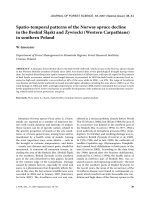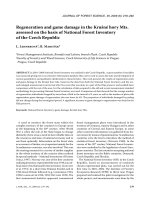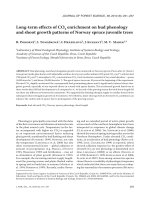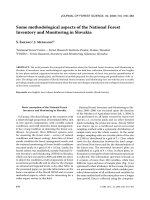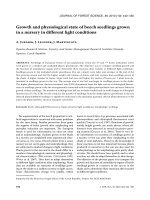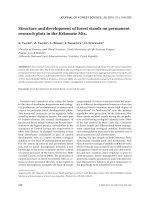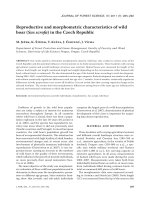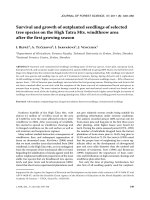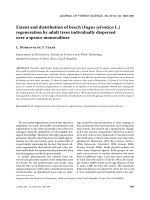Báo cáo lâm nghiệp: "Productivity and cost of manual felling with a chainsaw in Caspian forests" pptx
Bạn đang xem bản rút gọn của tài liệu. Xem và tải ngay bản đầy đủ của tài liệu tại đây (195.09 KB, 5 trang )
96 J. FOR. SCI., 55, 2009 (2): 96–100
JOURNAL OF FOREST SCIENCE, 55, 2009 (2): 96–100
e area of natural forests in Iran is approximately
12.4 million hectares, equal to 7.5% of the total area
of Iran. Approximately 1.9 million ha are commer-
cial forests called Caspian forests, Hyrcanian or
Northern forests (L, L 2007). e
commercial forests are located in the northern part
of Iran, between north of the Alborz Mountains and
south of the Caspian Sea. ese forests are uneven-
aged structures of varying species composition such
as beech (Fagus orientalis), hornbeam (Carpinus sp.),
maple (Acer sp.), oak (Quercus sp.) (L, L-
2007). In Iran, industrial logging is carried
only in the Caspian forests. High-quality hardwood
sawn timber is being harvested in these forests. In-
formation on the productivity, cost and application
of harvesting machines is a key component in the
evaluation of management plans for the rehabilita-
tion and utilization of Caspian forests (B et al.
2008). Due to the higher initial costs of mechanized
harvesting machines, larger diameters and crowns
of hardwoods, and the relatively steep terrain in
Caspian forests, manual felling with a chainsaw is
still the most commonly used system in the region.
Although, safety hazards increase, chainsaw felling
is not as limited by the ground slope or tree size as
is mechanized felling, manual felling is also used
to meet management objectives such as pre-com-
mercial thinning, salvage operations, and selective
harvesting. Few previous studies addressed the pro-
duction and cost of harvesting Caspian hardwood
stands under different machine and harvest pre-
scriptions. Many factors can affect the productivity
of chainsaws. J (1983) conducted a time study
on a 60-acre tract with three thinning treatments in
northern West Virginia. e three treatments were
defined as 45%, 60% and 75% of the residual stock-
ing. e harvest consisted of manual felling with a
chainsaw. Time studies showed that hourly felling
production increased while skidding productivity
decreased from the treatments 45%, to 60% and to
75% of residual stocking. Regression equations were
later developed based on the above time-study data
(B et al. 1986), which can be used for estimat-
ing production rates and costs for similar thinning
Productivity and cost of manual felling with a chainsaw
in Caspian forests
F. K. B
1
, B. M
1
, J. D
2
, M. N
1
, A. S
1
,
J. F
1
1
Faculty of Natural Resources, Teheran University, Teheran, Iran
2
Faculty of Forestry and Wood Sciences, Czech University of Life Sciences in Prague, Prague,
Czech Republic
ABSTRACT: A field production study was conducted for a manual harvesting system using a chainsaw in a Caspian
hardwood forest site. A selective cut was performed on a 42-hectare tract with an average slope of 30 percent. Felling
time per tree was most affected by diameter at breast height and by the distance among harvested trees. e gross and
net production rate was 20.6 m
3
and 26.1 m
3
per hour/one person, respectively. e unit cost considering the gross
and net production rate was 1.05 USD/m
3
and 0.81 USD/m
3
, respectively. e significant variables included diameter
at breast height (D) and distance among harvested trees (L) for the time expenditure model. is regression function
is statistically significant at α = 0.01.
Keywords: chainsaw; working efficiency; unit cost; felling
J. FOR. SCI., 55, 2009 (2): 96–100 97
operations. Some production/cost studies using
manual harvesting systems have been conducted in
harvesting planted pine stands in the south. K-
and S (1994) conducted a time study on a
southern pine harvest consisting of manual felling,
grapple skidding, and cable skidding. e harvest
method ranged from clear cutting to single-tree
selection and the proportion of basal area removed
was used to measure harvest intensity. L et al.
(1997) conducted a further analysis of southern pine
felling with chainsaws and produced several equa-
tions for estimating felling times and productivity.
W et al. (2004) developed a productivity model
for chainsaw felling, which included variables such
as diameter at breast height and the distance among
harvested trees. H et al. (2002) conducted a
time study on the forests of eastern Amazon, they
found that the productivity and cost of manual felling
were 20.46 m
3
/h and 0.46 USD, respectively.
N (2007) developed a productivity model for
chainsaw felling in Caspian hardwood forests, which
included variables such as diameter at breast height
and the distance among harvested trees. e objec-
tives of this study were to:
(1) Conduct a continuous time study on manual
harvesting systems with a chainsaw model Stihl
in a Caspian hardwood forest.
(2) Estimate the production rates and costs of chain
-
saw felling.
MATERIAL AND METHODS
Site of study
is study was carried out in compartment 231 in
Chafroud forests in the north of Iran. e altitude
ranged from 1,350 to 1,550 m above sea level and
the average annual precipitation was 1,450 mm.
e forest was an uneven-aged beech (Fagus orien-
talis Lipsky) stand with the average growing stock
320 m
3
/ha. e slope of the compartment was 20 to
60% and the aspects of the slopes were northern.
e total volume of production was 1,900 m
3
and
the skidding of production was done from the stump
area to the roadside landing by a ground-based skid-
ding system. e skidder type used in this study was
a Timberjack 450C wheeled skidder, with the power
of 177 HP and the weight was 10,257 kg (B
et al. 2008). Table 1 shows the characteristics of the
study area. Dominant canopy species include Fagus
orientalis, Carpinus betulus, Acer velutinum, Alnus
subcordata and Ulmus glabra. e canopy height
averages approximately 26 m.
e manual harvesting system examined consisted
of felling with a chainsaw. Felling was performed us-
ing a Stihl chainsaw with 3-horsepower (hp) engine
and bar length of 80 centimetres. e field study was
conducted in March 2006 in Chafroud forests, in the
north of Iran.
METHODS
Times and operational variables were measured
using a stopwatch and recorded on paper (L,
H 1997; B et al. 2008). e work cycle
for each operation consisted of certain elemental
functions and factors. e times for each function
and the value of each factor were recorded in the
field. Elemental time functions for chainsaw felling
were defined as: walk to tree, acquire, undercut,
back cut.
Harvesting factors or operational variables for
chainsaw felling measured in the field include dis-
tance to tree, tree species, diameter at breast height
(dbh) and ground slope in the felling area and ground
slope between two trees.
A total of 129 cycles for chainsaw felling was
observed in the field. e number of observations
varied depending on the amount of time required for
collecting time study data. Each felled tree was meas-
ured for dbh/butt diameter to the nearest centime-
tre. Local volume equations were used to compute
the volume of felled trees (Z 1994).
SPSS 14 was used to analyze the data. e response
variables were tested by Duncan’s multiple range test
at 0.05 levels. Regression techniques were also em-
ployed to develop models for elemental times, cycle
time, and productivity of chainsaw felling.
dbh of felled trees ranged from 40 to 273 cm and
averaged 87.62 cm (Table 1). e distance among
Table 1. Characteristics of the study area
Characteristics Study aspect Characteristics Study aspect
Forest district Chafroud Number of workers 3
Compartment number 231 Average field slope (%) 30
Altitude (m a.s.l.) 1,412 Silvicultural system selection cutting
Aspect Northern Kind of timber beech, alder
98 J. FOR. SCI., 55, 2009 (2): 96–100
harvested trees varied from 0 to 385 m with an av-
erage of 35.63 m (Table 1). In addition to the total
felling cycle we must consider delay time. e delay
times and the reasons for the delays were also re-
corded. ree categories of delays were used in the
delay analysis: personal delay, mechanical delay and
operational delay, which represent delays associ-
ated with the principle operating functions of the
system.
It was assumed that the skidding time per cycle
is a function of the above mentioned variables. e
stepwise regression model was applied to develop a
model. In this method, if any variable has a signifi-
cant effect on the RMS (Residual Mean Squares) of
the model, it would be used in the model.
RESULTS AND DISCUSSION
Table 2 presents the statistics of the operational
variables of wheeled skidding in the study area.
Table 3 shows the average working time and the
share of elemental times of working cycle obtained
in the Chafroud logging area with the Stihl chainsaw
model.
e gross and net productivities of chainsaw for
different diameters were 26.1 m
3
and 20.6 m
3
per
hour/one person, respectively. Estimates of hourly
costs of the chainsaw were computed using the ma-
chine rate method (M 1980). e unit costs
with and without delay times were 1.05 USD/m
3
and
0.81 USD/m
3
, respectively. e average lost time is
Table 2. Statistics of operational variables of the chainsaw felling in the study area
Variable
Standard
mean deviation minimum maximum
Harvest conditions
Diameter (cm) 87.62 28.07 40.00 273.00
Slope 1 (%) 32.86 15.72 0.65 89.00
Slope 2 (%) 25.23 9.68 0.00 60.00
Distance among felled trees (m) 35.63 49.36 0.00 385.00
Felling cycle time and elemental times (min)
Walk to tree 0.49 1.13 0.16 5.16
Acquire 0.06 0.04 0.03 0.27
Undercut 0.94 1.01 0.11 4.62
Back cut 0.73 1.17 0.09 6.57
Delay 0.81 2.18 0.48 68.67
Total felling time* 4.57 2.14 0.00 11.94
*Total felling time per tree does not include delays
Table 3. Average time and share of time segments
Elemental times of
working cycle
Time
(min) (%)
Walk to tree 0.49 16
Acquire 0.06 2
Undercut 0.94 31
Back cut 0.73 24
Felling 0.81 21
Delay 0.18 6
Total felling time 3.85 100
Delays
personal 0.22 27
mechanical 0.44 54
operation 0.15 19
Table 4. ANOVA model
Sum of squares df Mean square F-value p-value
Regression 841.20 2 420.60 350.64 0.00
Residual 151.14 126 1.20
Total 992.33 128
J. FOR. SCI., 55, 2009 (2): 96–100 99
0.81 min per working cycle, lost times (delays) were
taken from different places in the working area. e
stepwise regression analysis was applied to the time
study data base to develop a delay-free cycle time
equation. e significant variables included diam-
eter at breast height (D) in centimetres (Fig. 1) and
distance among harvested trees in m (L) (Fig. 2).
e cycle time equations calculated for the chainsaw
took the following form:
t = –2.80 + 0.051D + 0.039L
R
2
= 84.5%
(1)
This multiple correlation coefficient of 0.92 is
interpreted as the 84.5% of total variability, which
is explained by the regression equation. e sig-
nificance level of the ANOVA table (Table 4) shows
that the model is significant at α = 0.01. e SPSS 14
statistical program was applied according to its series
of phases in Table 2.
CONCLUSION
e variables such as distance between harvested
trees, diameter at breast height (dbh), slope in the
stump area, and slope between two harvested trees
were entered into the general model for predicting
felling time as significant variables, which can be ap-
plied in harvesting planning. e felling cycle time
per tree and felling productivity were mostly affected
by dbh of the tree being felled but they were also
affected by the distance between harvested trees.
Increasing distance between harvested trees will
increase felling time, but if dbh increases, the felling
time decreases. e average productivity of 26.1 m
3
per productive machine hour (PMH)/one person
or 20.6 m
3
per schedule machine hours (SMH)/one
person provided the weekly production of 470.58
and 371.1 m
3
with chainsaw felling. Its total hourly
cost was 0.81 USD/PMH and 1.05 USD/SMH per
cubic meter, respectively.
e results of this study can be used to compare the
production and cost of other harvesting machines or
systems used in the region and will be helpful for
the loggers in selecting an appropriate system under
certain stand and harvest circumstances.
e mean of delay times was 0.8l min per turn,
which was 0.22, 0.44 and 0.15 min per turn for opera-
tional, mechanical and personal delays, respectively.
Obviously, mechanical delays are the most frequent.
After the mechanical delays, operational delays were
the most frequent. In order to prevent a decrease in
their efficiency and to reduce delay times the main-
tenance of machinery must be performed according
to the technical specification.
R e f e r e n ce s
BEHJOU F., MAJNOUNIAN B., NAMIRANIAN M.,
DVOŘÁK J.
, 2008. Time study and skidding capacity of
the wheeled skidder Timberjack 450C in Caspian forests.
Journal of Forest Science, 54: 183–188.
BROCK S.M., JONES K.D., MILLER G.W.
, 1986. Felling
and skidding costs associated with thinning a commercial
Appalachian hardwood stand in northern West Virginia.
Northern Journal of Applied Forestry, 3: 159–163.
HOLMES T.P., BLAT G.M., ZWEEDE J.C., PEREIRA R.,
BARRETO P., BOLTZ F., BAUCH R.
, 2002. Financial and
ecological indicators of reduced impact logging perform-
ance in the eastern Amazon. Forest Ecology and Manage-
ment, 163: 93–110.
JONES K.D.,
1983. Time Study Analysis of ree inning
Treatments in Mixed Oak-Cove Hardwood Stands in
Northern West Virginia. [Master’s esis.] Morgantown,
West Virginia University, Division of Forestry: 98.
KLUENDER R.A., STOKES B.J.,
1994. Productivity and costs
of three harvesting methods. Southern Journal of Applied
Forestry, 18: 168–174.
R
2
= 0.50
0
5
10
15
20
25
30
0 50 100 150 200 250 300
Diameter (mm)
Cycle time (min)
R
2
= 0.59
0
5
10
15
20
25
30
0 100 200 300 400 500
Distance among harvester trees (m)
Cycle time (min)
Fig. 1. Effects of tree diameter on felling time per cycle
Fig. 2. Effects of distance among harvested trees on felling
time per cycle
100 J. FOR. SCI., 55, 2009 (2): 96–100
LEDOUX C.B., HUYLER N.K., 1997. Cycle time equation
for the Koller K300 cable yarder operating on steep slopes
in the Northeast. USDA, Forest Service, Research Paper
NE-705: 6.
LIMAEI S.M., LOHMANDER P.,
2007. Stumpage prices in
the Iranian Caspian forests. Pakistan Journal of Biological
Science, 6: 1027–1036.
LORTZ D., KLUENDER R., M
cCOY W., STOKES B.,
KLEPAC J.,
1997. Manual felling time and productivity in
southern forests. Forest Products Journal, 47: 59–63.
MIYATA E.S
., 1980. Determining fixed and operating costs of
logging equipment. St. Paul, USDA, Forest Service, General
Technical Report NC-55: 16.
NIKOIE M.,
2007. Optimization of Production Costs and
Reducing Logging Damages in Caspian Forests. [Ph.D.
esis.] Tehran, University of Tehran, Faculty of Natural
Resources: 214.
WANG J., CHARLIE L., MCNEEL J., BAUMGRAS J.,
2004.
Productivity and cost of manual felling and cable skidding
in central Appalachian hardwood forests. Forest Products
Journal, 53: 47–53.
ZOBEIRY M., 1994. Forest Inventory (Measurement of Tree
and Stand). University of Tehran, Faculty of Natural Re-
sources, Tehran University Publication: 401.
Received for publication July 15, 2008
Accepted after corrections October 5, 2008
Corresponding author:
Dipl. Ing. F K B, Teheran University, Faculty of Natural Resources, P.O. Box 31585–3314,
Teheran, Iran
tel.: + 98 0261 222 3044, fax: + 98 0261 224 9312, e-mail:
Výkonnost práce a ekonomické náklady při motomanuální těžbě
s motorovou pilou v kaspických lesích
ABSTRAKT: Časovou studii pro analýzu produktivity práce při motomanuální těžbě dříví s motorovou pilou
v listnatých lesích jsme realizovali v kaspických lesích. Výchovný zásah byl vyznačen a následně prováděn na ploše
42 ha s průměrnou sklonitostí terénu 30 procent. Závislost těžebního času byla nejvíce ovlivněna výčetní tloušťkou
kácených stromů a vzdáleností mezi vyznačenými stromy, určenými k těžbě. Průměrná výkonnost práce byla se
zohledněním časových ztrát během směny 20,6 m
3
/h a 26,1 m
3
/h v operativním čase. Průměrné výrobní náklady
činí 1,05 USD/m
3
s ohledem na vznikající časové ztráty. V případě nezapočtení ztrátových časů se náklady snižují
na 0,81 USD/m
3
. Nezávislé proměnné zahrnují v modelu spotřeby času výčetní tloušťku stromu (D) a rozestup mezi
těženými stromy (L). Regresní model je statisticky významný na hladině významnosti α = 0,01.
Klíčová slova: motorová pila; pracovní výkonnost; výrobní náklady; motomanuální těžba

